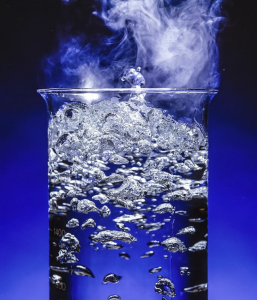CUTTING AI-DATA-CENTER COOLING ENERGY BY 50%, KRAMBU DEPLOYS FREON-FREE ELKHORN 970 LIQUID CHILLER
Independent power-meter readings show that a traditional water-cooled chiller consumes ≈ 170 kW of electricity to cool each 1 MW of IT load. The Elkhorn 970's water-only cycle delivers the same duty with ≈ 85 kW, a 50% reduction in cooling power and an effective COP ≈ 11.8—roughly double that of modern compressors. In practice this drives facility-only PUE from ~1.18 to ≈ 1.09.
During the April tech demo, a 2 hp Elkhorn 970 prototype removed a 3-ton (≈ 10.5 kW) GPU heat load while drawing just 1.93 kW
When evaluating cooling solutions per megawatt of AI compute, the efficiency differences are stark. Traditional water-cooled chiller plants requiring 7°C supply water consume approximately 170 kW of power with an effective COP of 5.9, utilizing high-GWP HFCs like R-134a and R-410A and resulting in facility PUE of about 1.18. Typical air or adiabatic-cooled chillers perform even worse, drawing 250-270 kW with COPs between 3.5-4.0. By contrast, the Elkhorn 970 v21 hydrovaporization cycle uses just 85 kW, achieving a remarkable COP of 11.8 while using only R-718 (water) as refrigerant and improving facility PUE to approximately 1.09. This translates to 50% energy savings versus high-efficiency chilled-water plants and 65% savings compared to conventional air/adiabatic chillers—squarely within the 50-90% cooling-energy reduction range documented in Elkhorn's technical white paper.
The Elkhorn system's superior performance stems from four key innovations: First, its compressor-free cycle relies on a water pump instead of energy-hungry compressors, avoiding the approximately 25% heat-of-compression penalty inherent in vapor-compression chillers. Second, water's exceptional latent heat as a working fluid allows the system to transfer the same heat load with roughly half the mass-flow and motor power required by HFC systems. Third, operating under vacuum eliminates the need for thick-wall vessels, oil separation hardware, and complex refrigerant management systems that create parasitic loads in traditional plants. Finally, using water instead of synthetic refrigerants removes all high-GWP chemicals from the site, eliminating Scope 1 emissions from cooling operations.
Because the Elkhorn 970 uses pure water (R-718) under vacuum as its working fluid, the deployment removed every kilogram of high-GWP refrigerant (e.g., R-134a/R-410A) from the mechanical room—eliminating leak-check maintenance and direct Scope 1 emissions. For capacity planning purposes, each megawatt of liquid-cooled GPUs using the Elkhorn 970 instead of legacy chillers saves approximately 745 MWh of electricity annually, avoiding roughly 300 metric tons of CO₂e (assuming 0.4 kg CO₂e/kWh grid intensity). Effectively, this system doubles the compute capacity that can be powered with the same cooling kVA while simultaneously advancing sustainability goals.
"For AI workloads, megawatts are the new currency," said Travis Jank, CEO of KRAMBU. "By halving cooling energy and ditching Freon entirely, the Elkhorn 970 lets us invest more power budget where it matters—into GPUs that accelerate our customers' models."
"KRAMBU's deployment proves that natural-refrigerant systems can out-perform legacy chillers at scale. We're thrilled to move from lab to live production together," added Heather Jones, CEO of Elkhorn Products.
About KRAMBU
KRAMBU, headquartered in Coeur d'Alene, Idaho, specializes in high-performance computing and digital infrastructure. With expertise in data center solutions, enterprise hardware, and systems optimization, KRAMBU delivers scalable solutions tailored to evolving technology needs.
Team Member
KRAMBU INC
info@krambu.com
Legal Disclaimer:
EIN Presswire provides this news content "as is" without warranty of any kind. We do not accept any responsibility or liability for the accuracy, content, images, videos, licenses, completeness, legality, or reliability of the information contained in this article. If you have any complaints or copyright issues related to this article, kindly contact the author above.
DME Service Solutions Achieves ISO/IEC 27001:2022 Certification, Strengthening Commitment to Data Security
Formalin Market Rising Business Opportunities with Prominent Investment Ratio by 2030 | AMR
$5.8 + Billion Natural Food Colors Market to Grow at 8.7% CAGR by 2035
Więcej ważnych informacji
 Jedynka Newserii
Jedynka Newserii

 Jedynka Newserii
Jedynka Newserii

Polityka

Firmy dzierżawiące grunty od Skarbu Państwa muszą zwrócić majątek rolny. Zagrożony jest też wspierany przez nich ośrodek rehabilitacyjny
Działalność ośrodka rehabilitacji dla dzieci z niepełnosprawnościami w Głubczycach, w województwie opolskim, jest zagrożona, o czym alarmuje Stowarzyszenie „Tacy Sami”. Zagrożenie jest konsekwencją restrukturyzacji spółki Top Farms Głubczyce, która jest jednym z największych pracodawców w okolicy i od lat wspiera działalność stowarzyszenia. Rolnicza spółka nie wie, jakie będą dalsze losy dzierżawionych do tej pory przez nią ziem, które w listopadzie br. muszą wrócić do Zasobu Skarbu Państwa. Zarząd spółki od wielu miesięcy apeluje do Krajowego Ośrodka Wsparcia Rolnictwa o wiążące decyzje w sprawie powołania Ośrodków Produkcji Rolniczej, które miałyby powstać na zwróconych gruntach, oraz kryteriów wyboru ich nowych dzierżawców.
Bankowość
Polskie kredyty hipoteczne wciąż jednymi z najdroższych w Europie. Zdaniem członka RPP odgórne ograniczanie marż banków się nie sprawdzi

Hipoteki w Polsce, co podkreśla też wielu polityków, należą do najdroższych w Europie. To nie tylko kwestia wysokości stóp procentowych, ale też marży banku. Zdaniem członka RPP prof. Ireneusza Dąbrowskiego jest tylko możliwość wpływania na ten pierwszy czynnik, bo regulacyjne ograniczenie wysokości marży byłoby trudne do wdrożenia.
Ochrona środowiska
Budowa morskich farm wiatrowych w Polsce szansą na kilkadziesiąt tysięcy nowych miejsc pracy. Wciąż brakuje jednak wykwalifikowanych pracowników

W Krajowym Planie w dziedzinie Energii i Klimatu rząd przewiduje zainstalowanie do 2030 roku około 5,9 GW w morskich farmach wiatrowych i kolejnych 12 GW w ciągu następnej dekady. Offshore ma być istotnym filarem dekarbonizacji krajowej gospodarki. Realizowane przez polskie spółki wraz z partnerami zagranicznymi projekty tzw. fazy I nabierają tempa i wkraczają w etap budowy infrastruktury na lądzie. Wśród wyzwań, które czekają wykonawców, jest m.in. brak pracowników z branży offshore. Pomocne może być ściąganie do kraju Polaków, którzy pracują na zagranicznych projektach morskich.
Partner serwisu
Szkolenia

Akademia Newserii
Akademia Newserii to projekt, w ramach którego najlepsi polscy dziennikarze biznesowi, giełdowi oraz lifestylowi, a także szkoleniowcy z wieloletnim doświadczeniem dzielą się swoją wiedzą nt. pracy z mediami.


![Nestlé w Polsce podsumowuje wpływ na krajową gospodarkę. Firma wygenerowała 0,6 proc. polskiego PKB [DEPESZA]](https://www.newseria.pl/files/1097841585/fabryka-nesquik_1,w_85,r_png,_small.png)






.gif)

 |
| |
| |
|